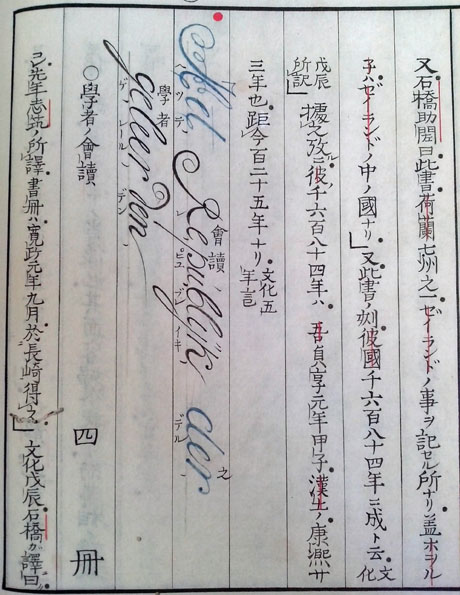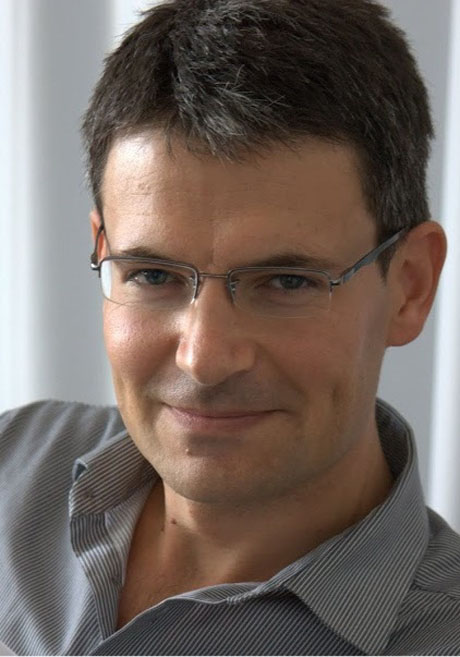Sketching Maps of a Eurasian Republic of Letters
In September 2014, David Mervart was a visiting scholar at the URPP Asia and Europe. He held a seminar and a lecture on current tendencies towards a “global” approach in the humanities. In this essay, he explains his concept of an intellectual historiography that carefully follows the winding paths of ideas between Asia and Europe.
David Mervart
Over recent years, histories of intellectual life have increasingly turned to theoretical and methodological ruminations on the possibility or necessity of going “global.” A host of attributes serves as an index to this tendency: “intercultural,” “cross-cultural,” “transcultural,” “transnational,” “entangled,” “world comparative,” and “global” tout court. Such terms have been variously floated as desirable modifiers of the agenda of intellectual or conceptual history. The purpose might be actually to turn the gaze toward objects and processes on a planet-wide scale, which sounds daunting. Or—perhaps more usefully and manageably—to try and build frameworks and approaches that would better do justice to our sense that the position of “the West” as the sole origin and anchor of universalisable modes of knowledge can no longer be tacitly taken for granted. Either way, this trend is worth interrogating, since it is driving some of the most momentous developments in the field.
In September 2014, I had the honour and pleasure to be invited by the URPP Asia and Europe to Zurich as the year’s visiting scholar and to address the above issues in a research seminar and a public talk organised by the institute. In a group of young researchers and doctoral candidates, we read and discussed some of the recent theoretical and methodological articulations of such “global” or border-crossing pretensions of intellectual and conceptual histories, including texts by Cemil Aydin, Anthony Grafton, Christopher Hill, Sudipta Kaviraj, Andrew Sartori, James Secord, or Sanjay Subrahmanyam. And since such articulations are certainly meant to connect to our practices as scholars, at each step we tried to test them on the material of our own research. The seminar participants brought in an intriguing array of research interests and dissertation
projects, ranging from private scholars in Tokugawa Japan who sought to synthesize Copernican astronomy and classical Confucian moral cosmology, through women’s groups magazines inspired by European models under the late Ottoman empire, to the cultural adaptations and normative legal deployments of the concept of ‘human rights’ in parts of the non-Western world.
A new toolbox
Each of these case studies obviously poses a challenge regarding the framework of organising the research and the questions asked of the material under study. How do we avoid reductionist assumptions about ‘western impact’ and ‘eastern reception?’ How do we do justice, descriptively and analytically, to the complexity of the processes of translation of one conceptual vocabulary into the terms of another, very different one? What analytical language might help us avoid essentialising cultural or ethnic identities and positing them as explanatory givens rather than problems to be explained? How can we dodge the trap of methodological nationalism? With these on our mind, we queried the new toolbox of generalisations, intuitions, descriptive vocabularies and narrative strategies proposed by our authors. Above all, we tried to see how helpful it might be in sketching histories of knowledge-formation and intellectual engagements that transgress the boundaries of supposedly stable cultural and linguistic units, including the latter-day nation states, whose claim extends so intrusively over the past of most recorded human experience.
Units of conversation
The problem clearly is that the existing blinders of established academic disciplines render certain instances of intellectual activity invisible, or at least much less visible than other instances deemed more typical and representative. Thus a record of a conversation among three French Enlightenment salon-goers or an instance of a Song interpretation of a pre-Han classic constitute units of historical material that readily pop up into the field of vision of, respectively, a historian of French Enlightenment and a classical Sinologist and are respectively filed away as material of ‘Enlightenment’ and ‘Chinese’ intellectual history. And having established disciplines to look after them, such instances as these are likely to receive sufficient coverage to become part of textbook narratives that trickle through popular accounts into common awareness.
But consider by contrast a conversation involving, say, a ‘Chinese’ text (the result of a Song re-interpretation of a canonised Han text with a pinch of Buddhist metaphysics), its Jesuit translation deployed back in Europe as part of the campaign to justify the order’s missionary policy, a Parisian salon-going deist quoting the same Jesuit translation, a Rotterdam-based reviewer’s excerpt of the work of that French philosophe and finally a Japanese interpreter’s use of the Dutch review to make sense of a fluid geopolitical situation following the war between the British and the Qing empires over imports of Bengali opium.
Such a unit of conversation is something that few of us are trained by our disciplines to even notice, let alone to describe and theorize. To students and lay publics alike it does not represent an intuitive instance of intellectual activity, making it much harder for it to enter any textbook-level general portrayal. And yet, similar instances are everywhere in evidence and they certainly do not wait for the arrival of the telegraphy or internet and for the self-conscious ‘globalization’ of a recent past. There is no reason why we should consider them less representative of ‘cultures’ or less formative of ‘traditions’ than instances of conversations conducted in the same language, at the same location and by people of the same ethnic group.
Formative connections across Eurasia
These pre-modern examples of cross-border transcultural motion and communicative permeability are not few and far between. They are common, even very common. They are certainly often based on misunderstandings rather than some multiculturally tolerant accommodation, but abuse and wilful or wishful misunderstanding are equally frequent and culturally productive modes of communication.
If we make our default units of study a little more complex, the national frameworks of reference quickly lose their supposedly intuitive appeal. Instead of studying a ‘Chinese’ thinker, let us take, for example, a person from eighteenth-century Nanjing who, despite a Chinese-sounding name and unquestioned allegiance to the Qing empire, operates as an Islamic scholar primarily in classical Arabic and Persian and seeks to translate Sufi texts into the conceptual language of the universal learning of most of the broader East Asian Sinosphere, the language of the classics we call ‘Confucian.’ Consider then that the resulting Chinese translation of a Sufi text is shipped by a Fujianese merchant (on a boat staffed by a motley crew of Malay sailors and a captain born of, say, a pirate of Japanese descent and a Cantonese boatpeople woman) to Nagasaki, where it is intercepted by censors as suspected Christian propaganda.
The Tokugawa censors (some of them offspring of Ming Chinese refugees from the continent) are effectively engaging in an implicit comparative study of religions as they operate on the assumption that otherworldly zeal of any hue is a danger to the stability of government. This assumption is formed from a mixture of first-hand experience with certain troublesome Buddhist sects and Christian converts and of the intelligence fed diligently by Dutch and English informers, who in the seventeenth century went out of their way to convince the new Tokugawa rulers that the subjects of Spanish and Portuguese Catholic kings are a threat to their neighbours everywhere and use religion to turn places into their colonies.
The resulting crackdown on all Christian proselytism (that we now know affected, among other things, Chinese translations of Islamic texts) was regarded with considerable sympathy by a (Protestant) Westphalian doctor visiting Japan, who described these measures as amounting to a systematic policy of ‘closed country,’ a felicitous policy at that, conducive to the internal peace and prosperity of the Tokugawa realm. This idealised description of the example of Tokugawa Japan was really intended as a lesson to a Europe troubled by the wars of religion and ambitious conquest. The vision of a country happily and prosperously closed off from international trade (geschlossener Handelsstaat) reverberates through European debates for a century afterwards. But when the Westphalian doctor’s Latin account of the ‘closed empire’ of Japan later finds its way back to Nagasaki, having been retranslated via English and Dutch into Japanese, it provides the Tokugawa authorities with a handy argument to fend off the demands to ‘open up’ the archipelago to international trade and diplomatic relations.
Every step of this dizzying chain of transmission, creative expropriation and adaptation of knowledge, text and argument is in fact entirely genuine and draws our attention to formative connections and translations that spanned the whole of Eurasia long before the supposed ‘globalization’ ushered the new age of a world connected. Indeed, there appears to have been no locally settled, disconnected, traditional world that a recent ‘globalization’ could arrive to supersede. But it is by similarly contingent processes that a discursive sphere that one may plausibly call ‘global’ has come into being. It is probably by carefully investigating stories like the ones above that we can hope to account for the emergence of a world of knowledge that we so intuitively perceive as global.
A useful metaphor
Perhaps rather than new general paradigms we need convincing and intuitive stories with which to talk about such connections and entanglements. These stories need to be as convincing, rich and self-supporting as the stories of essential cultural identities. To amass a stock of good stories with intuitive examples may be the best way to defy the essentialising inertia embedded in our disciplines and mindsets.
For any such enterprise, however, a label is useful, even indispensable. A good metaphor would do. And indeed, a long-established metaphor does exist in the western reaches of Eurasia for such a flurry of correspondence and trafficking in texts and ideas, unfettered by political, national or linguistic boundaries. It was the republic of letters, where the ‘letters’ stand for every form of learning and articulate knowledge. It is a lofty and improbably noble appellation. In the event, the trafficking was not always peaceful and fair, not nearly always based on an equality of parties involved. But the republic of letters at least implies that the element of communication and conversation is key to understanding the processes of generating knowledge and making sense of the world. It invites us to take seriously the processes of translation and transmission in all their historical contingency and to track the actual synapses along which they occurred. As metaphorical labels go, we could do worse than that.

Probably the first time the metaphor of ‘republic of letters’ was translated into any East Asian idiom, was in 1790s in a library catalogue in the castle town of Hirado, western Japan, under an entry on the acquisition of a Dutch journal that bore the same title: Het Republyk der Geleerden. The struggling translator, an official interpreter in Nagasaki, tried his best and rendered the peculiar phrase into Japanese as kaidoku, meaning a ‘reading group’ or a ‘seminar.’ Even as in our own seminar we tried to sketch a tentative map of some of the intellectual connections and co-productions of meaning that might be called a Eurasian republic of letters, I like to think of our reading group as a small fleeting embodiment of the republic of letters on Zürcher soil.
(Asia & Europe Bulletin, 4/2015, pp. 4–6)
